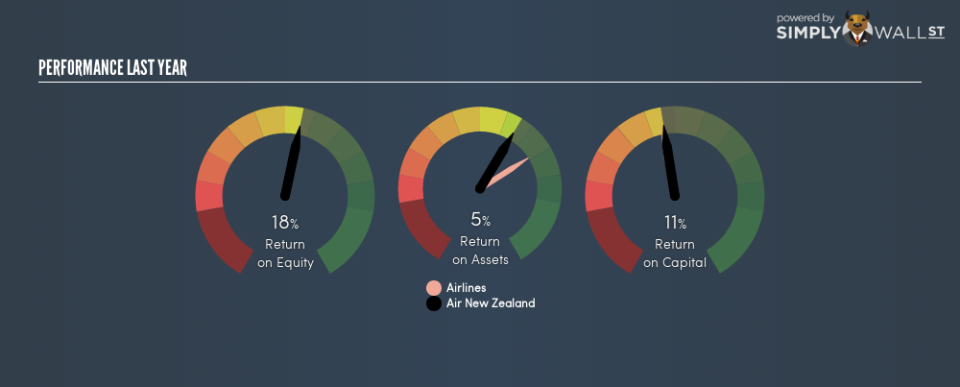Is Air New Zealand Limited (NZSE:AIR) Creating Value For Shareholders?

Today we’ll evaluate Air New Zealand Limited (NZSE:AIR) to determine whether it could have potential as an investment idea. Specifically, we’ll consider its Return On Capital Employed (ROCE), since that will give us an insight into how efficiently the business can generate profits from the capital it requires.
First, we’ll go over how we calculate ROCE. Next, we’ll compare it to others in its industry. And finally, we’ll look at how its current liabilities are impacting its ROCE.
Return On Capital Employed (ROCE): What is it?
ROCE is a metric for evaluating how much pre-tax income (in percentage terms) a company earns on the capital invested in its business. Generally speaking a higher ROCE is better. In brief, it is a useful tool, but it is not without drawbacks. Renowned investment researcher Michael Mauboussin has suggested that a high ROCE can indicate that ‘one dollar invested in the company generates value of more than one dollar’.
How Do You Calculate Return On Capital Employed?
The formula for calculating the return on capital employed is:
Return on Capital Employed = Earnings Before Interest and Tax (EBIT) ÷ (Total Assets – Current Liabilities)
Or for Air New Zealand:
0.11 = NZ$562m ÷ (NZ$7.8b – NZ$2.7b) (Based on the trailing twelve months to June 2018.)
Therefore, Air New Zealand has an ROCE of 11%.
View our latest analysis for Air New Zealand
Does Air New Zealand Have A Good ROCE?
ROCE can be useful when making comparisons, such as between similar companies. We can see Air New Zealand’s ROCE is around the 12% average reported by the Airlines industry. Separate from Air New Zealand’s performance relative to its industry, its ROCE in absolute terms looks satisfactory, and it may be worth researching in more depth.
It is important to remember that ROCE shows past performance, and is not necessarily predictive. Companies in cyclical industries can be difficult to understand using ROCE, as returns typically look high during boom times, and low during busts. ROCE is only a point-in-time measure. Future performance is what matters, and you can see analyst predictions in our free report on analyst forecasts for the company.
How Air New Zealand’s Current Liabilities Impact Its ROCE
Short term (or current) liabilities, are things like supplier invoices, overdrafts, or tax bills that need to be paid within 12 months. The ROCE equation subtracts current liabilities from capital employed, so a company with a lot of current liabilities appears to have less capital employed, and a higher ROCE than otherwise. To counter this, investors can check if a company has high current liabilities relative to total assets.
Air New Zealand has total assets of NZ$7.8b and current liabilities of NZ$2.7b. As a result, its current liabilities are equal to approximately 34% of its total assets. With this level of current liabilities, Air New Zealand’s ROCE is boosted somewhat.
The Bottom Line On Air New Zealand’s ROCE
While its ROCE looks good, it’s worth remembering that the current liabilities are making the business look better. Of course, you might find a fantastic investment by looking at a few good candidates. So take a peek at this free list of companies with modest (or no) debt, trading on a P/E below 20.
If you are like me, then you will not want to miss this free list of growing companies that insiders are buying.
To help readers see past the short term volatility of the financial market, we aim to bring you a long-term focused research analysis purely driven by fundamental data. Note that our analysis does not factor in the latest price-sensitive company announcements.
The author is an independent contributor and at the time of publication had no position in the stocks mentioned. For errors that warrant correction please contact the editor at editorial-team@simplywallst.com.

